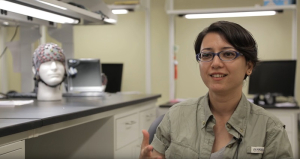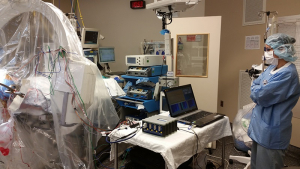Ilknur Telkes, a fourth-year biomedical Ph.D. student in the Cullen College of Engineering, spends a good bit of her time in the operating room at Baylor College of Medicine. Alongside Ashwin Viswanathan from BCM Neurosurgery and Joohi Jimenez-Shahed from BCM Neurology, she pinpoints areas in the brains of patients suffering from Parkinson’s disease with a new bipolar microelectrode, designed by Nuri Ince, assistant professor of biomedical engineering.
It is at the sites of these localization targets that deep brain stimulation electrodes will be placed to suppress symptoms of the disease. According to Telkes’ research, the new electrode is bringing better information to doctors than was delivered by the previously used singular microelectrode.
For her work in increasing the accuracy of target mapping and efficacy of brain surgery for Parkinson’s disease, Telkes has been named one of the 2017 North American Neuromodulation Society (NANS) Junior Scientist Award winners. In January, NANS will sponsor her participation as she presents her study on the device, "Feasibility of High Resolution Intraoperative LFP Recording with a Bipolar Microelectrode in Parkinson’s disease," at the NANS Annual Conference at Caesars Palace in Las Vegas, Nevada.
The Parkinson’s disease protocol
In some courses of Parkinson’s disease treatment, after medicine has failed, deep brain stimulation is used, with electrodes placed inside the brain to stimulate damaged regions. But before that can be done successfully, a surgeon must know exactly where to put the electrodes.
“Targeting and accurate localization of electrodes is very important for symptom suppression to benefit the patient,” said Telkes. “Accurate localization is the heart of the study.”
Ince’s microelectrode, manufactured by Microprobes Inc., has two stainless rings (bipolar), rather than one, which increases the resolution inside the brain.
Telkes’ study is proving the success of Ince’s bipolar electrodes and the intraoperative real-time signal processing system developed in his clinical neural engineering laboratory.
“We found very promising results in this study,” Telkes said.
Ince concurs. “We are in the early stage of testing it in surgeries. The initial pilot data is encouraging but we need more recordings to draw conclusions,” he said.
Telkes studies under Ince, who is wholeheartedly supportive of her work on many levels.
“Ilknur is actively attending surgeries to collect data and showed that our graduate students can contribute to the technology development in functional neurosurgery to treat Parkinson’s disease and other movement disorders,” said Ince.
Telkes’ work in this field was recently published in the Frontiers of Neuroscience journal. You can read it here.

